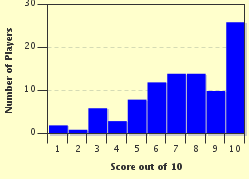Quiz Answer Key and Fun Facts
1. In the early 1980s, fossilized dinosaur bones were discovered near the Narmada River valley in Gujarat. Its unusual head crest led to it being named 'Rajasaurus'. What does 'Raja' mean in Sanskrit?
2. Another dinosaur which roamed parts of India is the Jainosaurus. Which of these was it named after?
3. Given that India was once part of the ancient landmass known as Gondwana, which other region of the world has similar fossil finds?
4. The Indosuchus was a bipedal carnivore that lived during the Late Cretaceous period. The Indo part of the name is easy to guess but what is 'suchus' derived from?
5. Fossils of trilobites have been found in the Zanskar Valley, which is part of the Himalayas. What do these fossils prove?
6. Which of the following terms best describes the sanajeh indicus? Fossilized remains have shown that it preyed on dinosaur eggs.
7. Which of these would you find in the Fossil Park at Sathanur in Tamil Nadu?
8. The Ghughua Fossil Park is famous for housing one of the oldest known fossils of which tree?
9. The Lameta Formation, which ranges across parts of central and western India, is well known for the dinosaur fossils found within it. Which rock type makes up this formation?
10. The Barapasaurus is a sauropod dinosaur whose remains have been discovered in the Kota Formation in Telangana in India. The genus has only one species, the B. tagorei, named after which of these?
Source: Author
zorba_scank
This quiz was reviewed by FunTrivia editor
rossian before going online.
Any errors found in FunTrivia content are routinely corrected through our feedback system.


